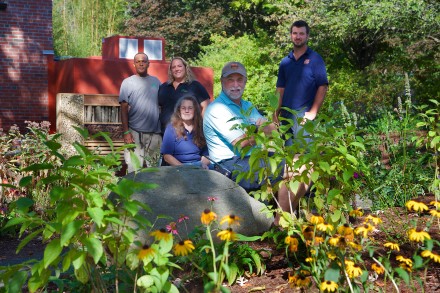
From Connecticut’s Beardsley Zoo:
Connecticut’s Beardsley Zoo is proud to unveil its latest installation, a certified Butterfly Garden and Bug Hotel, an important contribution to helping the area’s native butterfly population. Located in front of the new animal commissary, the garden is a gift from Stacey Marcell, her husband Wilbert Frazier, and their company, Northeast Horticultural Services.
Believing in the Zoo’s wildlife and conservation efforts, Stacey wanted to bring a unique exhibit that would be beautiful, educational, and sustainable. Her vision for a butterfly garden and bug hotel has materialized into an inviting attraction the community will enjoy for years to come.
Stacey strategically designed the garden to include a variety of host plants (plants that caterpillars like), and nectar plants (plants that butterflies like). The Northeast Horticultural Services crew installed a bounty of plants that are a source of food for Connecticut butterflies. Plants that butterflies love also draw other pollinators, including honey bees, bumblebees, moths, and beetles. Pollination is the process of transferring pollen from the anthers of one flower to the stigma of another. Butterflies, moths and bees excel at this, as do hummingbirds, some wasps, and nectar-feeding bats. Pollination is vital to the future of the earth.
“I have a long relationship with the City of Bridgeport and I have always loved Connecticut’s Beardsley Zoo,” said Marcell.
“I absolutely love educating people, and teaching people to be good stewards of the earth,” Marcell continued. “Whenever I plant anything, I’m leaving a legacy on this earth. I’m proud to leave this legacy at the Zoo.”
The Zoo garden includes a curved path made of bluestone dust, bordered by plants including butterfly bush, Monarda, Salvia, Asters, Coreopsis, Black-eyed Susan and more. A bug hotel is located at the end of the path to encourage pollinators to move in. Boulders were added as basking stones, where butterflies can warm themselves. Marcell donated the bluestone dust path, labor and installation, and dozens of beautiful plants, the handcrafted bug hotel as well as monthly maintenance for the garden.
A bug hotel has been installed, designed to offer nighttime protection, a place for overwintering, and egg laying capacity for a variety of insects, from ladybugs and praying mantises to butterflies, moths, and solitary bees. The holes drilled for the bees have even been sanded inside, to protect delicate wings from snagging on a rough surface.
“Stacey has given the Zoo a substantial gift of both beauty and sustainability,” said Zoo Director Gregg Dancho. “Just like the animals we have here at the Zoo, butterfly populations have plummeted due to increased herbicide and pesticide use, and habitat loss. This garden is one more way for us to sustain native populations of pollinators, critical to a healthy ecosystem.”
Stacey has been generously displaying her strong support for the Zoo since 2008, when she donated her time and resources to revitalize the Zoo’s Wetlands Aviary.
About Butterflies
Butterflies are large, colorful insects with wings covered with tiny scales. The scales are arranged in patterns unique to each species. Together with moths, butterflies make up the order Lepidoptera, with an estimated 15,000 butterfly species worldwide. Like all insects, butterflies have six legs and three main body parts: head, thorax, and abdomen. They also have two antennae and an exoskeleton. Butterflies are more active in the daytime, while moths are more active at night. A complete list of Connecticut butterflies, from Silver-bordered Fritillaries to Dreamy Duskywings, can be found at www.thebutterflysite.com/connecticut-butterflies.shtml.About Northeast Horticultural Services
Northeast Horticultural Services (www.northeasthorticultural.com) are organic plant and tree care specialists. Through the guidance and expertise of Stacey Marcell, licensed arborist and degreed horticulturalist, the company focuses on promoting the health, wellness and beauty of plants, trees and shrubs in Fairfield County, Connecticut. They are active members of the Connecticut Tree Protective Association, accredited members of the Tree Care Industry Association and accredited as organic land care providers with the Northeast Organic Farming Association.About Connecticut’s Beardsley Zoo
Spend the day a world away! Connecticut’s only zoo, celebrating its 95th anniversary, features 300 animals representing primarily North and South American species. Visitors won’t want to miss our Giant anteaters, Amur (Siberian) tigers, Brazilian ocelot, Red wolves, and Golden Lion tamarins. Other highlights include our South American rainforest with free-flight aviary, the prairie dog exhibit with “pop-up” viewing areas, the New England Farmyard with goats, cows, pigs, sheep, and other barnyard critters, plus the hoofstock trail featuring bison, pronghorn, deer, and more. Visitors can grab a bite at the Peacock Café, eat in the Picnic Grove, and enjoy a ride on our colorful carousel. For more information, visit beardsleyzoo.com.

